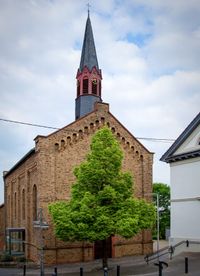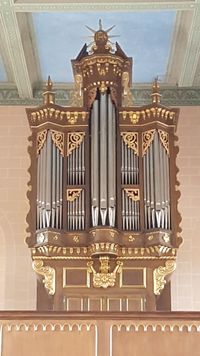The organ of Johann Peter Geissel
One major reason why art friends find their way to Gau Bischofsheim is due to the fact that a disused organ from the parish of St. Christoph in Mainz was sold to our village in 1773 and survived in the church of St. Petrus. In Mainz it would have been destroyed by bombs in World War II. We owe the organ scholar Dr. Franz Boesken and his research a reliable documentation of the development of this oldest organ in Rhineland-Palatinate. According to this, Johann Peter Geissel, born in Worms in 1636, son of the organ maker Georg Geissel of Gernsheim, built the organ for St. Christoph in Mainz in 1667. The church was the baptistery of Johannes Gensfleisch, known as Gutenberg, who introduced letterpress printing with his movable-type printing press. The church ruins are preserved as a memorial. The contract of July 9, 1667 still exists and contains the original register disposition. It was a one-manual work of nine sounding registers, without a pedal.
The work cost 450 Florentine guilders at the time. J.P. Geissel already, who was organist at St. Christoph from 1668 to around 1688, made the first changes to the instrument in 1688. As this organ was replaced in 1772 by a new one, built by the Frankfurt organ builder Ernst Wegmann, the Geissel organ was sold to Gau-Bischofsheim. F. Boesken found the evidence for that in the archives of the diocese of the Mainz Cathedral as an entry in the income register (see picture on the left) of St. Christoph. "On March 3, 1773, the rural municipality of Gaubischeim bought the old organ for 150 fl (Florentine guilders)“ and paid the sum by instalments. It was an important piece of equipment for the new baroque church, built in Gau-Bischofsheim in 1725, which replaced a previous building.
In 1847 the organ underwent changes in terms of a softer, more romantic sound. A soft 8' Salicional was used for the bright Nazard register and a softer 8' flute for the prominent trumpet. This work was carried out by the organ builder Jakob Koehler. A separate pedal and a 16' bass, standing behind the mechanics on a special console, were added in 1870 by Philip Embach, Mainz.
In the war year 1917 the front pipes were confiscated for war armament. After the war the pipes of the Mixtur 1' were replaced by a new 3-fold Mixture 2'. The current state of the construction of the organ is the result of a restoration by the organ building company Gebr. Oberlinger, Windesheim, in 1972. According to the status of research and restoration practice at the time, the registration of the organ was restored to the sound of the Geissel organ from 1667. The pedals were retained and two more pedal registers were added.
The organ today satisfies an interpretation of stylistically diverse organ literature and thus enriches church services enormously. Five manual registers and essential parts of the case are still preserved from the original organ of Johann Peter Geissel. Reason enough to call this fully playable mechanics the oldest organ in Rhineland-Palatinate and in the diocese of Mainz.
Since 1988, this very special cultural asset of the Rhineland-Palatinate and the jewel of the small Rhine-Hessian wine-growing community a few kilometers south of Mainz has been regularly presented to friends of organ music beyond the scope of church services. In concerts with renowned national and international artists this treasure has been made accessible to a broad public.
.png/picture-200?_=1829786c868)



